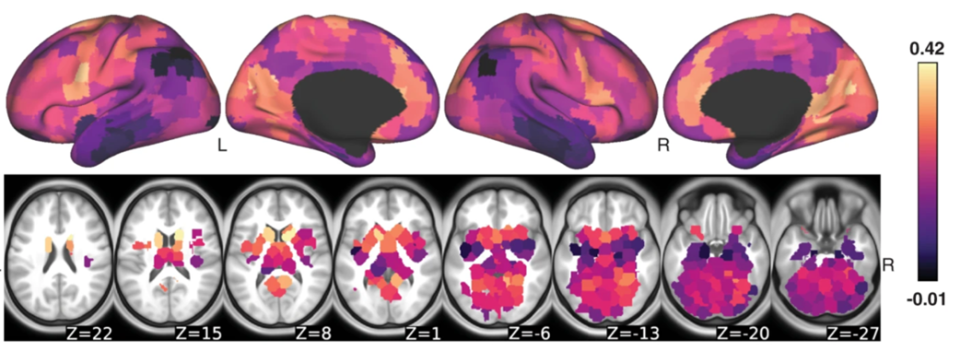Award or grant: National Institutes of Health/National Institute of Mental Health (NIH/NIMH): 1RF1MH123232
The human brain is an unimaginably complicated system of interconnected neurons capable of complex thought, emotion and behavior. Macroscale white matter connections quantified via the structural connectome (SC) act as the backbone for the flow of functional activation, which can be represented via the functional connectome (FC).
Our group and others have shown that quantifying properties of the brain’s structural and functional connectomes and their relationship can inform understanding of brain-behavior associations and disease mechanisms. However, models that describe SC-FC relationships have only achieved moderate agreement with observations, and have not been used to fully explore the heritability and cognitive implications of structure-function coupling in adult and developing populations. If we can't accurately understand how the brain’s anatomy and physiology are linked across the human lifespan, then we can't quantify the impact of disease or pathological developmental trajectories. Our long-term goal: create computational tools for studying the brain’s structure and function, particularly in the context of disease. The objective of this project (which is being conducted in conjunction with the team of Mert Sabuncu, Ph.D.): create a model that accurately and interpretably quantifies the coupling between the structural and functional connectomes in both sexes, which will in turn let us investigate the heritability and cognitive implications of SC-FC coupling across developing and adult populations. Our central hypothesis is that a hybrid approach to predicting FC from SC, combining both biophysical modeling and deep learning, will be more accurate than existing techniques. Based on prior literature and our preliminary data, the lab hypothesizes that SC-FC coupling will vary with sex, be heritable, associated with development, and explain inter-subject variability in cognition. Our hypothesis is supported by preliminary data from our group and others that show SC-FC relationships are heritable and vary with sex and cognition in patients. The rationale for this work is that having an accurate model of the SC-FC relationship in healthy populations, which currently does not exist, will further our understanding of the complex relationship between anatomy, physiology, sex, genetics and cognition.
The lab will test the central hypothesis via three Specific Aims: 1) Identify the most accurate model for predicting FC from SC; 2) Quantify the heritability of SC-FC coupling and its association with cognitive performance; 3) Characterize the SC-FC coupling trajectory and its cognitive implications throughout development. The lab will use neuroimaging, genetic and cognitive data from the Human Connectome Project, including young adult (~1000 individuals, 22-37 years) and developing populations (~650 individuals, 5-21 years). The approach is innovative, as it proposes to use model-driven, data-driven and hybrid approaches to model SC-FC relationships, and proposes to explore sex effects, heritability, cognitive and developmental implications of SC-FC relationships. The research is significant in that understanding structure-function relationships across typical development will allow quantification of disease impact and reveal avenues for novel treatments in various neurological diseases. Although this is a recently awarded grant, the lab has already published some of our findings demonstrating SC-FC coupling varies widely across brain regions, but 1) was strongest in highly structurally connected visual and subcortical areas, 2) had interindividual regional differences based on age, sex and composite cognitive scores and 3) was highly heritable within certain networks. These results suggest regional structure-function coupling is an idiosyncratic feature of brain organization that may be influenced by genetic factors. Gu Z., et al., Heritability and interindividual variability of regional structure-function coupling, Nat. Commun.: 2021.


